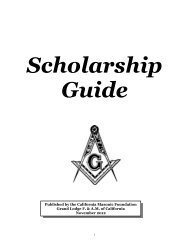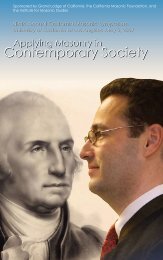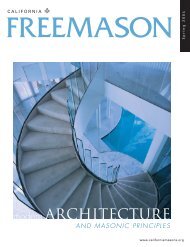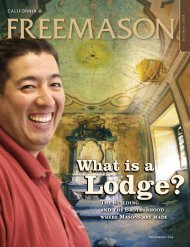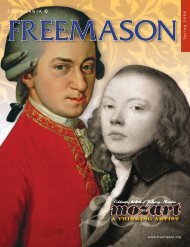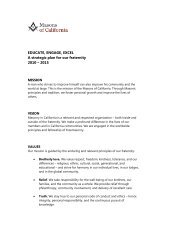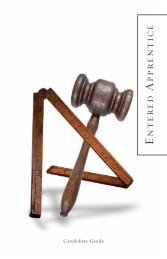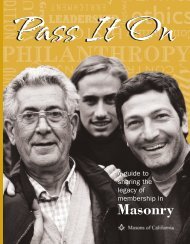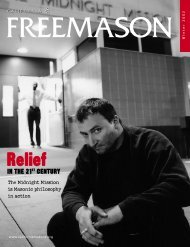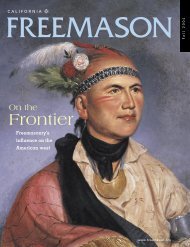Winter 2004 - Freemason.org
Winter 2004 - Freemason.org
Winter 2004 - Freemason.org
You also want an ePaper? Increase the reach of your titles
YUMPU automatically turns print PDFs into web optimized ePapers that Google loves.
COVER STORY<br />
Treasure,” which weaves Masonry into<br />
a dizzying plot to steal the Declaration<br />
of Independence in an attempt to<br />
protect an ancient treasure hidden by<br />
the Founding Fathers. The clues to the<br />
treasure are on a secret map on the<br />
back of the document, as well as all over<br />
the commonly circulated dollar bill.<br />
“National Treasure” writers Cormac<br />
and Marianne Wibberley didn’t know<br />
much about Masonry when they<br />
started working on their script, and<br />
headed to their local library to do<br />
some research. “We went up to the<br />
circulation desk to ask a question, and<br />
there was this guy wearing a Masonic<br />
ring and necklace. It was a sign! We<br />
found out that there was a Masonic<br />
lodge not two miles from our house.”<br />
If art does indeed imitate life, it<br />
is not surprising that Hollywood<br />
has often explored the supposed<br />
“dark side” of Masonry. The 1826<br />
disappearance of a New York man<br />
named William M<strong>org</strong>an ignited<br />
a national firestorm of criticism,<br />
and two years later the Anti-<br />
Masons became the first third<br />
party in American history to field<br />
a presidential candidate. In the<br />
1832 election the Anti-Masons won<br />
seven electoral votes, and for several<br />
decades prominent Americans,<br />
including John Quincy Adams<br />
and William Seward, issued stern<br />
warnings about the influence of the<br />
brotherhood. M<strong>org</strong>an’s widow later<br />
married Joseph Smith, founder of the<br />
Mormon Church, and William M<strong>org</strong>an<br />
was actually given a post-mortem<br />
baptism in the Church of Latterday<br />
Saints. For many conspiracy<br />
aficionados, this is further evidence<br />
of a far-ranging plot that includes<br />
a stunning array of alleged fellow<br />
travelers including the Jews, the<br />
Illuminati, the Trilateral Commission,<br />
the Bilderberg Group, and the Vatican.<br />
In creating “National Treasure,”<br />
the Wibberleys focused their interest<br />
on a specific—and intriguing—plot<br />
line. “Our story doesn’t deal with<br />
the religious, world-domination, or<br />
supernatural aspects of some other<br />
Hollywood conspiracy movies. Ours<br />
simply poses the questions: What<br />
if our Founding Fathers really were<br />
protecting the famous Templar<br />
treasure, which had been lost in<br />
France centuries ago? What if they left<br />
behind clues that only other Masons<br />
could decipher? What if the treasure<br />
is buried here in America, right under<br />
our noses?”<br />
Continued on page 14<br />
Cinema is the modern storyteller for our collective<br />
human mythologies and fantasies. The great Swedish<br />
director Ingmar Bergman once noted “no art passes<br />
our conscience in the way film does.” One of the<br />
ways that movies make such an impression is by<br />
creating—and reinforcing—images that convey strong<br />
associations. <strong>Freemason</strong>ry’s mystique, symbolism, and,<br />
its secrecy have long been employed by Hollywood<br />
to provide “instant recognition” for the audience. In<br />
many ways, the craft provides perfect shorthand for<br />
filmmakers who want to convey an air of secrecy and<br />
conspiracy. And Masonic references show up in films of<br />
all genres, from sci-fi to westerns.<br />
California <strong>Freemason</strong> 12 <strong>Winter</strong> <strong>2004</strong><br />
Robert Zuckerman © <strong>2004</strong> Buena Vista Pictures Distribution. All rights reserved .<br />
“True Grit”<br />
(1969) Starring John Wayne. Directed by Henry Hathaway.<br />
(Western)<br />
Widely regarded as John Wayne’s best film, it features the<br />
Duke as one-eyed sheriff Rooster Cogburn helping a young<br />
girl and a gruff bounty hunter track down her father’s killer.<br />
The trio heads off into uncharted Indian territory in search of<br />
justice, and in one of the movie’s most moving scenes, the girl<br />
informs Wayne that she wants her father to be buried in his<br />
Masonic apron.




